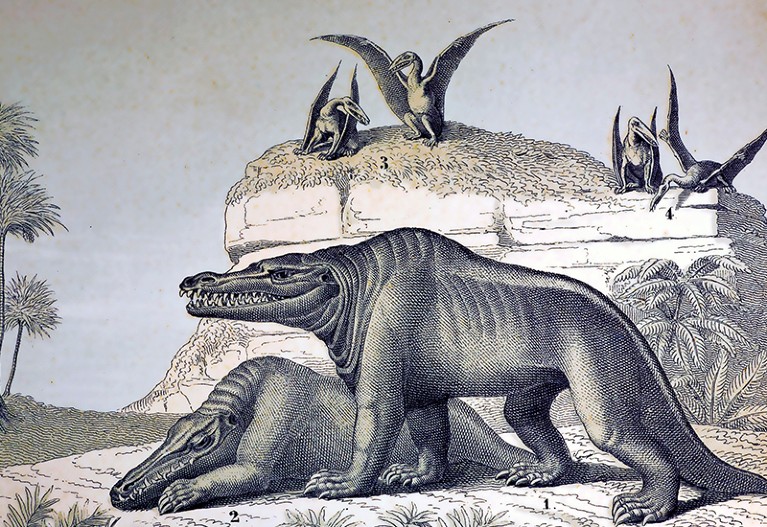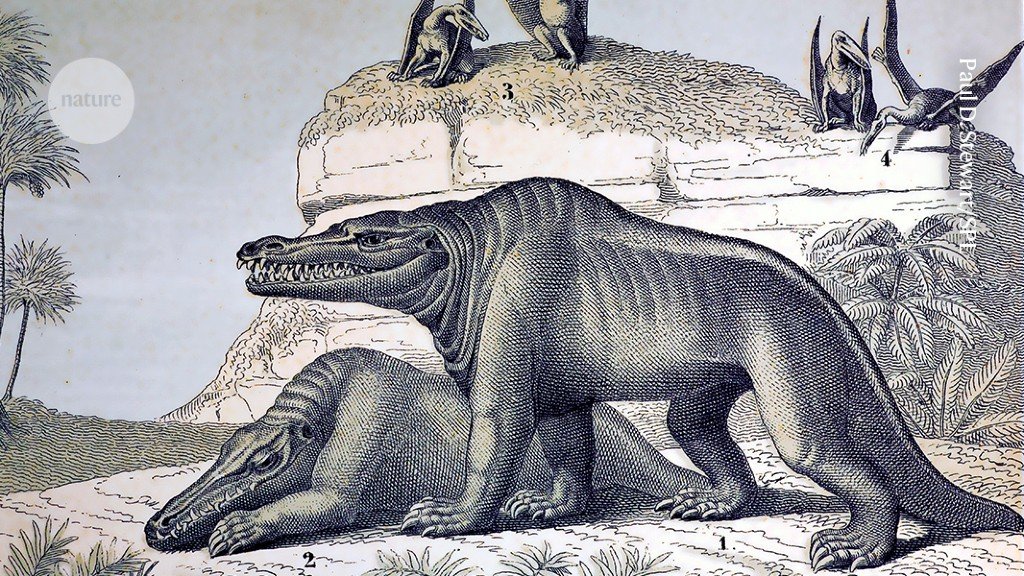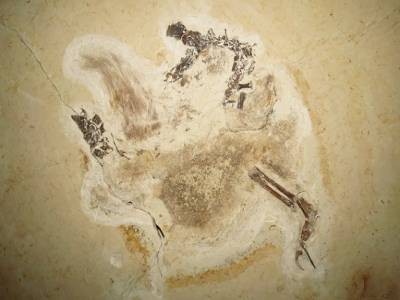
An 1862 illustration of Megalosaurus, the first dinosaur to be named.Credit: Paul D. Stewart/SPL
It’s been 200 years since scientists named the first dinosaur: Megalosaurus. In the centuries since, hundreds of other dinosaur species have been discovered and catalogued — their names inspired by everything from their physical characteristics to the scientists who first described them. Now, some researchers are calling for the introduction of a more robust system, which they say would ensure species names are more inclusive and representative of where and how fossils are discovered.
Megalosaurus was named by William Buckland, a minister and geologist who discovered the enormous reptile’s fossilized remains in a field in Stonesfield, UK, in 1824. Buckland chose the name Megalosaurus on account of the immense size of the bones he and others had excavated. “It was a sensation — the first gigantic extinct land reptile ever discovered,” says Paul Barrett, a palaeontologist at the Natural History Museum in London. “Such an animal had never been conceived of before.” The word dinosaur — from the Greek meaning ‘fearfully great lizard’ — was introduced later, in 1841.
Unlike in other scientific disciplines — such as chemistry, in which strict rules govern a molecule’s name — zoologists have a relatively free reign over the naming of new species. Usually, the scientist or group that first publishes work about an organism gets to pick its name, with few restrictions. There is a set of guidelines for species naming overseen by the International Commission on Zoological Nomenclature (ICZN). These include the requirements that the name is unique, that it is announced in a publication and that, for dinosaurs, it is linked to a single specimen.
Problematic names
To explore how dinosaur naming has changed over the past 200 years, Emma Dunne, a palaeobiologist at Friedrich-Alexander University in Erlangen–Nuremberg, Germany, and her colleagues analysed the names of all of the dinosaur fossils from the Mesozoic Era (251.9 million to 66 million years ago) that have been described, around 1,500 in total.
The authors wanted to know how much effort it would take to address what they saw as problematic names, which they describe as those “emanating racism, sexism, named under (neo)colonial contexts or after controversial figures”. They found 89 potentially offensive names, equating to less than 3% of the dinosaurs they looked at. (One widely cited example of an ‘offensive’ species name — outside palaeontology — belongs to a beetle named after Adolf Hitler.)
Prized dinosaur fossil will finally be returned to Brazil
Some of the names the team identified derive from the colonial names for lands where species have been discovered. Indigenous-language names of places or researchers are often not used or are mistranslated, the authors say.
For example, many of the dinosaurs discovered during a series of expeditions between 1908 and 1920 by German explorers in Tendaguru in Tanzania, which was then part of German East Africa, were named after German people rather than local expedition members, and the samples remain in Germany.
“The problem in terms of numbers is really insignificant. But it is significant in terms of importance,” says Evangelos Vlachos, a co-author of Dunne’s paper and a palaeontologist at the Museum of Paleontology Egidio Feruglio in Trelew, Chubut, Argentina. He wants future naming systems to be more rigorous. “We don’t say that tomorrow we need to change everything. But we need to critically revise what we have done, see what we have done well and what we have not done well, and try to correct it in the future.”
The use of eponyms — naming a species after a person or people — has become much more common in recent years, with 55% of names that are eponyms having been given in the past 20 years, the authors say. They found that in instances in which a species has a gendered name ending, 87% were masculine. They recommend reverting to descriptive names, such as Stegosaurus (from ‘roof lizard’ in Greek, referring to the animal’s plate-like spines) or Triceratops (‘three-horned-face’). This also adds to the usefulness of the name for communication, they say.
The team’s analysis has not yet been published or peer-reviewed.
No name changes
The ICZN is firmly against going back and renaming species whose names might now be considered offensive, and would not consider banning eponyms, says ICZN president Thomas Pape, a taxonomist at the Natural History Museum of Denmark in Copenhagen. “We do not recommend renaming unless there are what we would call formal nomenclatural reasons,” he adds. This is because the organization places great importance on preserving the ‘stability’ of names, and this could be threatened if they are changed retrospectively, he says.
Landmark Colombian bird study repeated to right colonial-era wrongs
The ICZN would consider introducing different naming systems, Pape says, perhaps including repositories for names to be peer-reviewed, or insisting that names can be considered official only if they are first published in a certain set of journals. But no formal changes are currently planned.
Meanwhile, Barrett says, some palaeontologists are trying to drive change within the community. “There’s been a marked change in the desire to credit formerly overlooked figures when naming new dinosaurs and to ensure that issues of patrimony are faced and accounted for,” he says. He adds that Indigenous collaborators and colleagues are more often recognized, “whereas previously most eponyms reflected the roles of scientists in the global north”. Many researchers also try to use names derived from the languages, interests and traditions in countries where dinosaur remains are discovered, helping to foster community engagement and to reflect the historical context of the material.
Dunne says that although she would like to see change, she doesn’t want to add further unpaid work to the burdens facing academics. “But there does need to be something,” she says, adding that the ICZN “could do better and be more representative of the community”.



